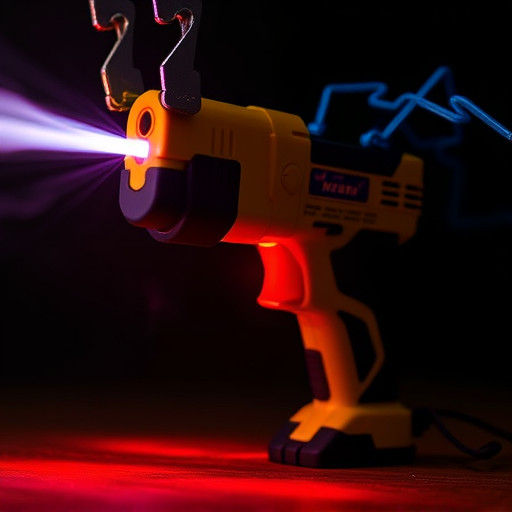Choosing the right stun gun voltage (80,000-150,000 kV) involves balancing power and safety. Higher voltages are effective for close-quarters self-defense but carry more risk, while lower voltages are safer for non-lethal scenarios. Check local laws regarding voltage limits to ensure legal compliance. Effective stun guns penetrate clothing, with current, pulse width, and construction quality also impacting performance. Safety features like automatic shut-off mechanisms and low voltage settings are crucial, along with staying informed about regional regulations and adjustable settings up to 12,000 volts or less for personal protection.
Considering purchasing a stun gun? Understanding the right voltage is crucial for effectiveness and safety. This guide breaks down everything you need to know about stun gun voltages, from basic functionality to legal considerations. We explore the ideal voltage ranges based on intended use and highlight key factors to ensure you make an informed decision. Discover what sets apart a good stun gun voltage and stay prepared with confidence.
Understanding Stun Gun Voltages: What They Mean
Understanding Stun Gun Voltages: What They Mean
When considering what is a good stun gun voltage, it’s essential to know that stun guns use electrical current to disrupt muscle control in an assailant, causing them to temporarily lose balance and strength. The voltage, measured in thousands of volts (kV), represents the power delivered by the device. Higher voltage doesn’t always mean more effectiveness; it depends on factors like the amount of current and the duration of the pulse. Generally, stun guns range from 50,000 to 120,000 volts, with many experts suggesting a range between 80,000 to 100,000 volts as an effective balance for stopping an attacker without causing serious harm.
Choosing the right voltage involves striking a delicate balance. Lower voltages may not be powerful enough to disable an assailant, while extremely high voltages can increase the risk of injury or even cardiac arrest if used improperly. For personal defense purposes, a stun gun with adjustable voltage settings is ideal, allowing users to customize the power based on their specific needs and level of comfort. This flexibility ensures that you have the right amount of force for each situation, making your stun gun a more versatile and effective self-defense tool.
Factors to Consider When Choosing Stun Gun Voltage
When choosing the right voltage for your stun gun, there are several factors to consider. Firstly, understand that the voltage determines the level of shock and immobilization the device can deliver. Higher voltage generally means a more powerful stun, but it’s not as simple as picking the highest number. The key is finding a balance between effectiveness and safety.
Consider your intended use and personal safety needs. For self-defense in close quarters, a higher voltage may be beneficial to quickly disable an attacker. However, lower voltages are often sufficient for non-lethal force scenarios or for those concerned about accidental discharges that could cause serious harm. Additionally, check local laws regarding stun gun voltage limits and ensure the device complies with regulations to avoid legal issues.
Common Stun Gun Voltage Ranges and Their Effectiveness
When considering what voltage to get for your stun gun, it’s important to understand that the effectiveness of a stun device isn’t solely determined by its voltage. Stun guns deliver an electric shock through two metal probes, temporarily disrupting muscle control and causing the target to stumble or fall. Common stun gun voltage ranges typically fall between 50,000 and 150,000 volts. A good stun gun voltage should be high enough to penetrate clothing and skin, ensuring a strong shock that neutralizes an attacker quickly.
However, voltage alone doesn’t guarantee safety or effectiveness. Other factors like the device’s current (measured in amps), pulse width, and the quality of construction play significant roles. For personal protection, many experts recommend stun guns with voltages in the higher end of this range, around 120,000 to 150,000 volts. This ensures a powerful enough shock to deter most would-be assailants while also considering the importance of safety features that prevent accidental discharge and ensure user protection.
Safety Precautions and Legal Considerations for High-Voltage Devices
When considering a stun gun, understanding safety precautions and legal considerations is paramount. High-voltage devices like stun guns deliver electric shocks that can be powerful enough to incapacitate an assailant for a brief period, but they also come with inherent risks and potential legal repercussions. Always prioritize safety by choosing a device with proper certifications and designed according to industry standards. Ensure it includes features like automatic shut-off mechanisms and low voltage settings to minimize the risk of accidental harm or misuse.
Moreover, be aware of local laws and regulations regarding stun guns. Different regions have varying restrictions on who can possess such devices and under what circumstances. Some areas require permits or registration, while others may limit the voltage levels allowed for personal protection stun guns. Staying informed about these legal aspects is crucial to ensure compliance and avoid potential legal issues surrounding the use of high-voltage devices like stun guns. In terms of what is a good stun gun voltage, consider starting with models that offer adjustable settings up to 12,000 volts or less, which generally provide an effective range without exceeding safe limits for personal use.
